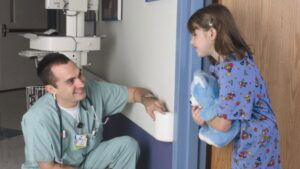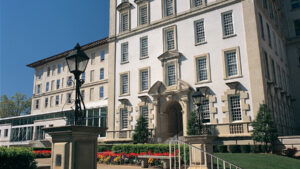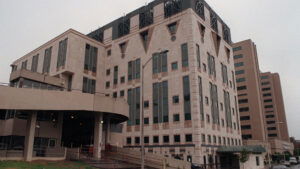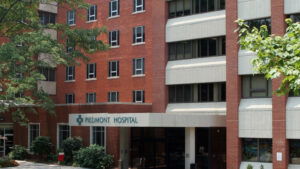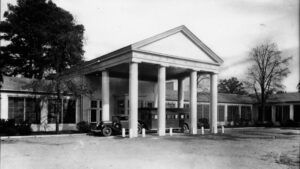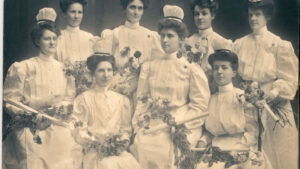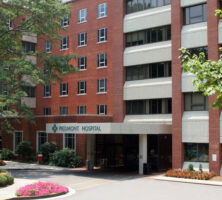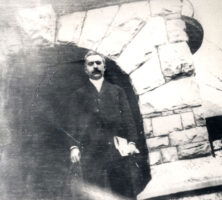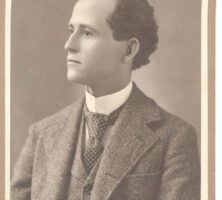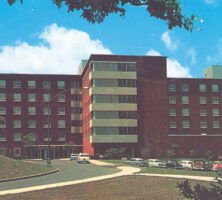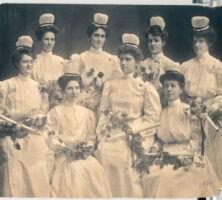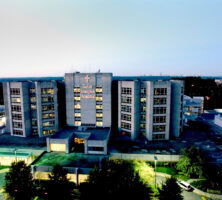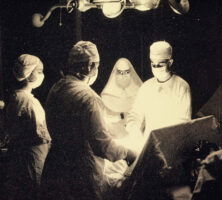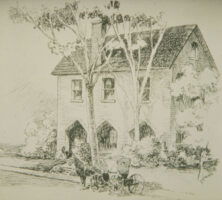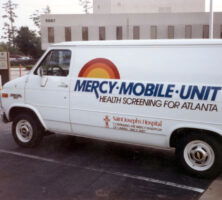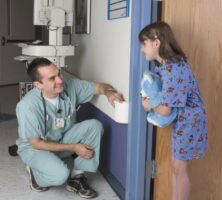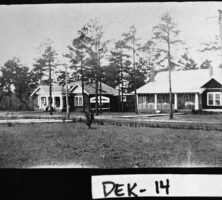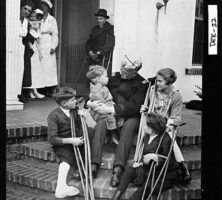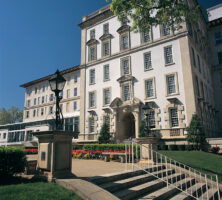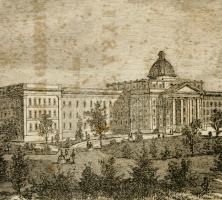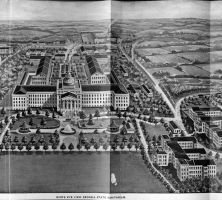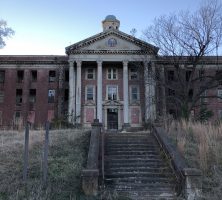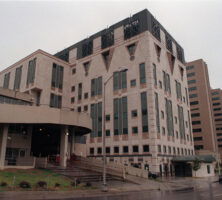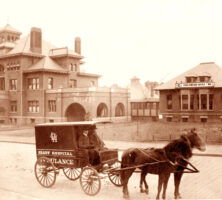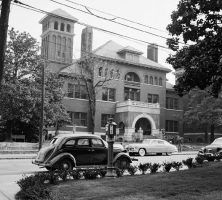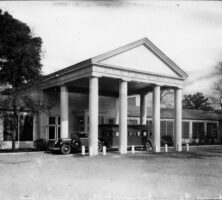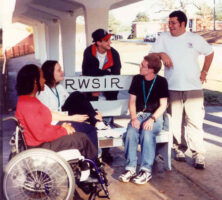The New Georgia Encyclopedia is supported by funding from A More Perfect Union, a special initiative of the National Endowment for the Humanities.
Piedmont Hospital, located in the Buckhead community of Atlanta, is a private, not-for-profit institution founded in 1905. An acute tertiary-care facility, Piedmont Hospital is the flagship institution of Piedmont Healthcare.
Courtesy of Piedmont Hospital Archives
The New Georgia Encyclopedia does not hold the copyright for this media resource and can neither grant nor deny permission to republish or reproduce the image online or in print. All requests for permission to publish or reproduce the resource must be submitted to the rights holder.
The first facility for Piedmont Hospital, pictured circa 1915, was a fifteen-room home located at the corner of Capitol Avenue and Crumley Street in downtown Atlanta. The hospital, founded in 1905 as Piedmont Sanatorium, remained in this location until 1957.
Courtesy of Piedmont Hospital Archives
The New Georgia Encyclopedia does not hold the copyright for this media resource and can neither grant nor deny permission to republish or reproduce the image online or in print. All requests for permission to publish or reproduce the resource must be submitted to the rights holder.
Dr. Ludwig Amster, a specialist in gastrointestinal diseases, stands outside the Piedmont Sanatorium circa 1920. Amster founded the facility, known today as Piedmont Hospital, in 1905 with surgeon Dr. Floyd W. McRae Sr.
Courtesy of Piedmont Hospital Archives
The New Georgia Encyclopedia does not hold the copyright for this media resource and can neither grant nor deny permission to republish or reproduce the image online or in print. All requests for permission to publish or reproduce the resource must be submitted to the rights holder.
Dr. Floyd W. McRae Sr., pictured in 1895, was a surgeon and the cofounder of Piedmont Sanatorium (later Piedmont Hospital), which opened in 1905 in downtown Atlanta.
Photograph from C. W. Motes, in Piedmont Hospital Archives
The New Georgia Encyclopedia does not hold the copyright for this media resource and can neither grant nor deny permission to republish or reproduce the image online or in print. All requests for permission to publish or reproduce the resource must be submitted to the rights holder.
In 1957 Piedmont Hosptial, pictured circa 1960, moved from downtown Atlanta to the Buckhead community of Atlanta. At that time the facility had 250 beds and a staff of 127 physicians.
Courtesy of Piedmont Hospital Archives
The New Georgia Encyclopedia does not hold the copyright for this media resource and can neither grant nor deny permission to republish or reproduce the image online or in print. All requests for permission to publish or reproduce the resource must be submitted to the rights holder.
Graduates of Saint Joseph's Nursing School in Atlanta pose in 1906. The nursing school opened in 1900 and operated until 1973, graduating a total of more than 1,300 nurses.
Courtesy of Saint Joseph's Hospital
The New Georgia Encyclopedia does not hold the copyright for this media resource and can neither grant nor deny permission to republish or reproduce the image online or in print. All requests for permission to publish or reproduce the resource must be submitted to the rights holder.
Saint Joseph's Hospital, located on a thirty-two-acre campus in north Atlanta since 1973, is the oldest medical facility in Atlanta. Founded by Catholic nuns in 1880, Saint Joseph's is nationally recognized for excellence in both patient care and research.
Courtesy of Saint Joseph's Hospital
The New Georgia Encyclopedia does not hold the copyright for this media resource and can neither grant nor deny permission to republish or reproduce the image online or in print. All requests for permission to publish or reproduce the resource must be submitted to the rights holder.
Saint Joseph's Hospital in Atlanta has been a forerunner in the Southeast for developing surgical procedures, from performing the region's first open-heart surgery in 1957 to utilizing minimally invasive robotic surgery in the twenty-first century.
Courtesy of Saint Joseph's Hospital
The New Georgia Encyclopedia does not hold the copyright for this media resource and can neither grant nor deny permission to republish or reproduce the image online or in print. All requests for permission to publish or reproduce the resource must be submitted to the rights holder.
Saint Joseph's Hospital, originally known as Atlanta Hospital, first opened in a home on Baker Street in Atlanta. The facility later moved to a building on Courtland Street before dedicating its current location in north Atlanta in 1973.
Courtesy of Saint Joseph's Hospital
The New Georgia Encyclopedia does not hold the copyright for this media resource and can neither grant nor deny permission to republish or reproduce the image online or in print. All requests for permission to publish or reproduce the resource must be submitted to the rights holder.
As part of its original mission to offer medical care to the poor, Saint Joseph's Hospital in Atlanta operates the Mercy Care Services program, which includes two health clinics and eight mobile satellite locations as of 2007.
Courtesy of Saint Joseph's Hospital
The New Georgia Encyclopedia does not hold the copyright for this media resource and can neither grant nor deny permission to republish or reproduce the image online or in print. All requests for permission to publish or reproduce the resource must be submitted to the rights holder.
Children's Healthcare of Atlanta was formed in 1998 by the merger of Egleston Children's Health Care System and the Scottish Rite Children's Medical Center. A not-for-profit pediatric hospital, Children's served approximately 493,000 patients in 2005.
Courtesy of Children's Healthcare of Atlanta
The New Georgia Encyclopedia does not hold the copyright for this media resource and can neither grant nor deny permission to republish or reproduce the image online or in print. All requests for permission to publish or reproduce the resource must be submitted to the rights holder.
The Scottish Rite Convalescent Home for Crippled Children, pictured circa 1916, consisted of two wood-frame cottages. The facility opened in Decatur in 1915 and provided post-surgical care to indigent children.
Courtesy of Georgia Archives, Vanishing Georgia, #
dek014.
The New Georgia Encyclopedia does not hold the copyright for this media resource and can neither grant nor deny permission to republish or reproduce the image online or in print. Requests for permission to publish or reproduce the resource should be submitted to the Georgia Archives.
In 2003 Dante Priebe (right) underwent a successful liver-transplant operation, performed by Dr. Thomas Heffron (left) at Children's Healthcare of Atlanta.
Courtesy of Children's Healthcare of Atlanta
The New Georgia Encyclopedia does not hold the copyright for this media resource and can neither grant nor deny permission to republish or reproduce the image online or in print. All requests for permission to publish or reproduce the resource must be submitted to the rights holder.
Patients at the Scottish Rite Hospital for Crippled Children in Decatur are pictured circa 1920. Founded in 1915, the Scottish Rite Hospital merged with the Henrietta Egleston Hospital for Children in 1998 to form Children's Healthcare of Atlanta.
Courtesy of Georgia Archives, Vanishing Georgia, #
dek022.
The New Georgia Encyclopedia does not hold the copyright for this media resource and can neither grant nor deny permission to republish or reproduce the image online or in print. Requests for permission to publish or reproduce the resource should be submitted to the Georgia Archives.
Emory University Hospital, located on the campus of Emory University in Atlanta, is a tertiary care facility. Staffed by 1500 physicians, the facility has been the site of several important milestones in the medical history of Georgia, including the performance of the state's first heart, kidney, and lung transplants.
Courtesy of Emory University Hospital
The New Georgia Encyclopedia does not hold the copyright for this media resource and can neither grant nor deny permission to republish or reproduce the image online or in print. All requests for permission to publish or reproduce the resource must be submitted to the rights holder.
A class of graduating nurses poses outside Wesley Memorial Hospital in Atlanta, later Emory University Hospital, in 1916. Wesley Memorial, chartered in 1904, was located in a mansion on Courtland Street until 1922, when the hospital moved to the Emory University campus in DeKalb County.
Courtesy of Georgia Archives, Vanishing Georgia, #
ful0408.
The New Georgia Encyclopedia does not hold the copyright for this media resource and can neither grant nor deny permission to republish or reproduce the image online or in print. Requests for permission to publish or reproduce the resource should be submitted to the Georgia Archives.
The Powell Building at Central State Hospital near Milledgeville was the original building of the Georgia Lunatic Asylum when it first opened in 1842. Named after Superintendent Theophilus O. Powell (1837–1907), the building's role changed multiple times over its long history, most recently serving as an administrative center for Central State Hospital.
Courtesy of Jonathan D. Hepworth, New Georgia Encyclopedia
The New Georgia Encyclopedia does not hold the copyright for this media resource and can neither grant nor deny permission to republish or reproduce the image online or in print. All requests for permission to publish or reproduce the resource must be submitted to the rights holder.
The main building of the Georgia Lunatic Asylum (now called the Powell Building of Central State Hospital) near Milledgeville first opened to receive patients in 1842. This engraving of the domed building is taken from an 1861 report by the asylum.
From Duke University
The New Georgia Encyclopedia does not hold the copyright for this media resource and can neither grant nor deny permission to republish or reproduce the image online or in print. All requests for permission to publish or reproduce the resource must be submitted to the rights holder.
By the time this bird's eye drawing was made for the 1913 Georgia State Sanitarium report, the institution had expanded substantially beyond the domed Powell Building (left center). A convalescent female ward (bottom right) was mirrored by a convalescent male ward (bottom left), while an overcrowded building for African Americans had been recently completed (top, center fold). The "twin buildings" (x-shaped, top left) housed white male patients and were connected by a kitchen and dining complex. The sanitarium's farm stretched out beyond.
From University of Georgia Libraries
The New Georgia Encyclopedia does not hold the copyright for this media resource and can neither grant nor deny permission to republish or reproduce the image online or in print. All requests for permission to publish or reproduce the resource must be submitted to the rights holder.
The Jones Building at Central State Hospital was completed in the late 1920s. It originally housed the Psychopathic Hospital of Milledgeville State Hospital. Largely abandoned a decade ago, its condition has deteriorated extensively as shown in this 2021 photo.
Courtesy of Jonathan D. Hepworth, New Georgia Encyclopedia
The New Georgia Encyclopedia does not hold the copyright for this media resource and can neither grant nor deny permission to republish or reproduce the image online or in print. All requests for permission to publish or reproduce the resource must be submitted to the rights holder.
Central State Hospital in Milledgeville, pictured in 2000, has provided mental health care in Georgia since 1837. Today the hospital's services include specialized care as well as secure facilities for the state's criminal justice system.
Courtesy of Central State Hospital
The New Georgia Encyclopedia does not hold the copyright for this media resource and can neither grant nor deny permission to republish or reproduce the image online or in print. All requests for permission to publish or reproduce the resource must be submitted to the rights holder.
This tinted postcard of the Georgia State Sanitarium (later Central State Hospital) depicts the grounds of the institution circa 1905. During this time the hospital was under the leadership of Theophilus O. Powell, who implemented more precise methods of diagnosis.
Courtesy of Melinda Smith Mullikin, New Georgia Encyclopedia
The New Georgia Encyclopedia does not hold the copyright for this media resource and can neither grant nor deny permission to republish or reproduce the image online or in print. All requests for permission to publish or reproduce the resource must be submitted to the rights holder.
The New Georgia Encyclopedia does not hold the copyright for this media resource and can neither grant nor deny permission to republish or reproduce the image online or in print. All requests for permission to publish or reproduce the resource must be submitted to the rights holder.
Grady Memorial Hospital, a major teaching hospital in Atlanta, provides care to more than 1 million outpatients annually. The building, designed in the modern style by Robert and Company, was completed in 1958. In the early 1990s, the hospital was renovated and expanded by Stanley, Love-Stanley.
Courtesy of Atlanta Journal-Constitution.
The New Georgia Encyclopedia does not hold the copyright for this media resource and can neither grant nor deny permission to republish or reproduce the image online or in print. All requests for permission to publish or reproduce the resource must be submitted to the Atlanta Journal-Constitution.
An ambulance waits in front of Grady Memorial Hospital in 1896. Named in honor of journalist Henry W. Grady, the hospital was built in downtown Atlanta in 1892.
The New Georgia Encyclopedia does not hold the copyright for this media resource and can neither grant nor deny permission to republish or reproduce the image online or in print. Requests for permission to publish or reproduce the resource should be submitted to Special Collections and Archives at Georgia State University.
African American children work on art projects at Grady Hospital in 1953. The hospital, segregated until the 1960s, was often referred to as "the Gradies" because of its separate facilities for Black patients and white patients.
Courtesy of Special Collections & Archives, Georgia State University Library, Lane Brothers Commercial Photographers Photographic Collection.
The New Georgia Encyclopedia does not hold the copyright for this media resource and can neither grant nor deny permission to republish or reproduce the image online or in print. Requests for permission to publish or reproduce the resource should be submitted to Special Collections and Archives at Georgia State University.
Grady Memorial Hospital has often been among the first to implement new medical technology. The hospital's most notable achievements include performing the state's first open-heart surgery in 1921, opening the world's first cancer center in 1923, and acquiring the earliest dialysis and X-ray machines. Grady Hospital's original building, shown here in 1952, was re-purposed when the hospital built new structures for white and Black patients in 1912.
Courtesy of Special Collections & Archives, Georgia State University Library, Lane Brothers Commercial Photographers Photographic Collection.
The New Georgia Encyclopedia does not hold the copyright for this media resource and can neither grant nor deny permission to republish or reproduce the image online or in print. Requests for permission to publish or reproduce the resource should be submitted to Special Collections and Archives at Georgia State University.
Georgia Hall was the first building to be constructed after Franklin D. Roosevelt purchased the property and turned the facility into a polio treatment center in 1927. The building was paid for with nickels and dimes sent by people from all over Georgia.
Courtesy of the Roosevelt Warm Springs Institute for Rehabilitation
The New Georgia Encyclopedia does not hold the copyright for this media resource and can neither grant nor deny permission to republish or reproduce the image online or in print. All requests for permission to publish or reproduce the resource must be submitted to the rights holder.
Camp Dream was developed in the early 1990s as a place where disability camps could be held. It includes two lodges, a fully accessible swimming pool and boat dock, and paved nature trails along the base of Pine Mountain.
Courtesy of the Roosevelt Warm Springs Institute for Rehabilitation
The New Georgia Encyclopedia does not hold the copyright for this media resource and can neither grant nor deny permission to republish or reproduce the image online or in print. All requests for permission to publish or reproduce the resource must be submitted to the rights holder.
In the 1930s polio sufferers flocked to Warm Springs, the site of U.S. president Franklin D. Roosevelt's treatment center. Georgia Hall is pictured.
The New Georgia Encyclopedia does not hold the copyright for this media resource and can neither grant nor deny permission to republish or reproduce the image online or in print. All requests for permission to publish or reproduce the resource must be submitted to the rights holder.
On a quarter-by-quarter basis, disabled young people from all over Georgia can reside at the Vocational Rehabilitation Unit while improving their academic, job, and independent-living skills.
Courtesy of the Roosevelt Warm Springs Institute for Rehabilitation
The New Georgia Encyclopedia does not hold the copyright for this media resource and can neither grant nor deny permission to republish or reproduce the image online or in print. All requests for permission to publish or reproduce the resource must be submitted to the rights holder.
Aquatic excercise classes are held in the 25-meter pool, at the Center for Therapeutic Recreation.
Courtesy of the Roosevelt Warm Springs Institute for Rehabilitation
The New Georgia Encyclopedia does not hold the copyright for this media resource and can neither grant nor deny permission to republish or reproduce the image online or in print. All requests for permission to publish or reproduce the resource must be submitted to the rights holder.

